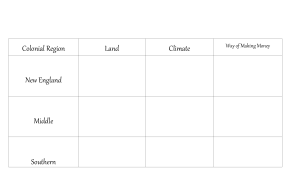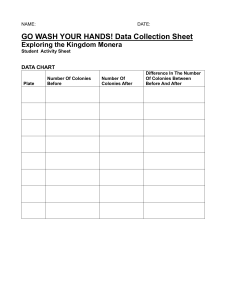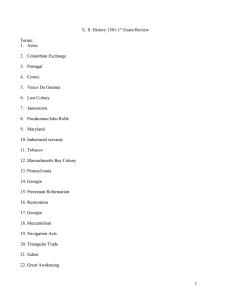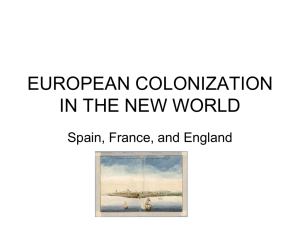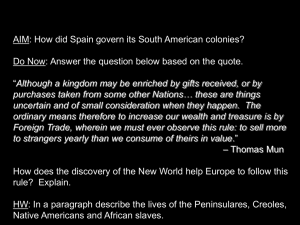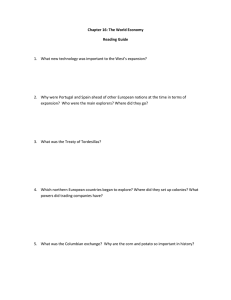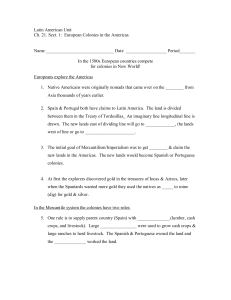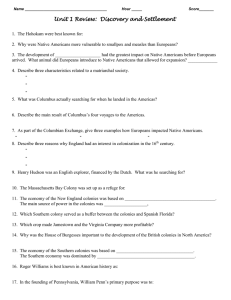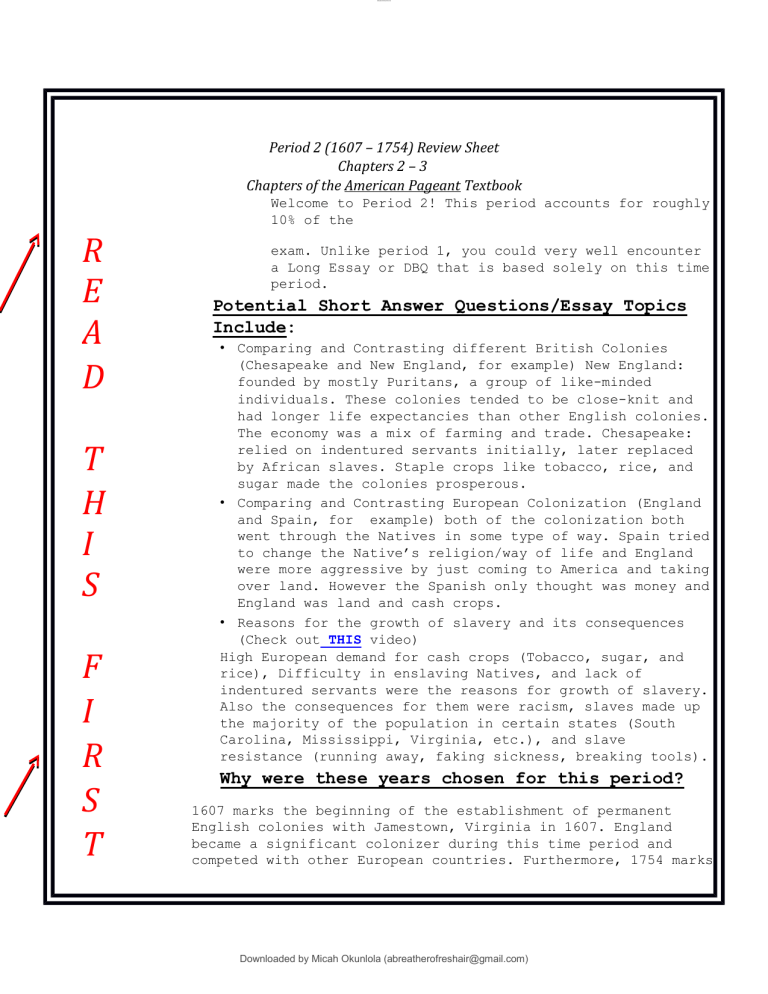
lOMoAR cPSD| 30134818 Period 2 (1607 – 1754) Review Sheet Chapters 2 – 3 Chapters of the American Pageant Textbook Welcome to Period 2! This period accounts for roughly 10% of the R E A D T H I S F I R S T exam. Unlike period 1, you could very well encounter a Long Essay or DBQ that is based solely on this time period. Potential Short Answer Questions/Essay Topics Include: • Comparing and Contrasting different British Colonies (Chesapeake and New England, for example) New England: founded by mostly Puritans, a group of like-minded individuals. These colonies tended to be close-knit and had longer life expectancies than other English colonies. The economy was a mix of farming and trade. Chesapeake: relied on indentured servants initially, later replaced by African slaves. Staple crops like tobacco, rice, and sugar made the colonies prosperous. • Comparing and Contrasting European Colonization (England and Spain, for example) both of the colonization both went through the Natives in some type of way. Spain tried to change the Native’s religion/way of life and England were more aggressive by just coming to America and taking over land. However the Spanish only thought was money and England was land and cash crops. • Reasons for the growth of slavery and its consequences (Check out THIS video) High European demand for cash crops (Tobacco, sugar, and rice), Difficulty in enslaving Natives, and lack of indentured servants were the reasons for growth of slavery. Also the consequences for them were racism, slaves made up the majority of the population in certain states (South Carolina, Mississippi, Virginia, etc.), and slave resistance (running away, faking sickness, breaking tools). Why were these years chosen for this period? 1607 marks the beginning of the establishment of permanent English colonies with Jamestown, Virginia in 1607. England became a significant colonizer during this time period and competed with other European countries. Furthermore, 1754 marks Downloaded by Micah Okunlola (abreatherofreshair@gmail.com) lOMoAR cPSD| 30134818 ! the beginning of the 7 Years War (French and Indian) predominantly between the English and the French. Key vocabulary terms to know for this time period: Characteristics of Spanish colonization - focused on converting Natives and gaining wealth through tight control over colonies. (Think 3 Gs - period #1) Characteristics of French and Dutch colonization - fewer inhabitants than other countries. The French and Dutch focused on trade (especially fur), alliances, and intermarriage with Native Americans. Characteristics of English colonization - colonies were based on agriculture. English colonies saw a large number of men AND women inhabit the colonies. The English had relatively hostile relations with Native Americans. Pueblo Revolt - Native American revolt in the late 17th century in present-day New Mexico against the Spanish. The Spanish were expelled for over 10 years. Once they regained control, the Downloaded by Micah Okunlola (abreatherofreshair@gmail.com) lOMoAR cPSD| 30134818 Spanish began to take a more accommodating approach to Natives and allowed some religious accommodation. The Enlightenment - Time period that focused on reason and knowledge and promoted new ideas about government (natural rights, consent of the governed, separation of powers). These ideas helped influence the American Revolution. Mercantilism Economic policy that focuses on making money for the mother country. This policy favors a positive balance of trade for the mother country and the accumulation of gold and silver. Anglicization - Process of colonies becoming and acting British. This was influenced by print culture (newspapers and writings) and communities based on English models. Characteristics of New England colonies - founded by mostly Puritans, a group of like-minded individuals. These colonies tended to be close-knit and had longer life expectancies than other English colonies. The economy was a mix of farming and trade. Characteristics of middle colonies - These colonies were the most diverse religiously and saw the most immigrants from Europe. The economy was based on grain. Characteristics of southern colonies - The Chesapeake (Maryland and Virginia) relied on indentured servants initially, later replaced by African slaves. Staple crops like tobacco, rice, and sugar made the colonies prosperous. Watch THIS video on Period 2 before you proceed. (Less than 10 minutes) 1. For each of the following countries, provide a brief summary of the goals/characteristics of colonization in the Western Hemisphere. Please make sure you include the DEMOGRAPHICS – makeup of the population. Want more info? Check out THIS video. • Spain: Spain became the early leader in exploration. They settled in South America in the SW US. The Spanish sought out precious metals including gold and silver. Most Spanish settlers were men, leading to racially mixed population with the natives. Mestizo is the mix of the Spanish and Native ancestry, in Mullato is a mix of Spanish and African ancestry. • Dutch and French: The Dutch established trade posts in NY. Dutch sent few Europeans to settle and formed alliances and intermarried with natives. Samuel de Champlain founded in Quebec, Downloaded by Micah Okunlola (abreatherofreshair@gmail.com) lOMoAR cPSD| 30134818 • which was one year later from Jamestown. Most of colonists were men. The French focused on fur trade with Natives. The French had no representative assembly. English: The permanent settlement was Jamestown in 1607. They settled along the Atlantic which is present day US and Caribbean. The English applied the same tactics used in Ireland towards the Natives. England sent; large amounts of men and women to colonize colonies and focused on agriculture, and had hostile relationships with Natives. 2. How did characteristics of British colonization differ from Spanish colonization? Natives were seen as “savages to the English, and they were excluded from settlements. Whereas the Spanish lived among the Natives. 3. What were three reasons for the development of the slave trade? Racial superiority, lack of indentured servants, and natives were harder to enslave are reasons for the development of slave trade. 4. Why can the Pueblo Revolt be seen as a WATERSHED event in Spanish colonial history? (Make sure you know WATERSHED!) Need info on the Pueblo Revolt? Check out THIS video. The pueblo revolt was seen as a water shed event as a result of the rapid religious consumption by the newly introduced Spanish. 5. What does Anglicization mean? What are examples of this occurring? The English cultural and societal spread to the colonies; can be seen through the result of the Protest Reformation and spread of enlightment ideas. 6. What is Mercantilism? How did colonists get around this policy? Mercantilism is a system in which colonies could only trade with their said country of origin, enforced by bans and taxes. 7. How did the Enlightenment encourage colonial resistance? Encouraged free thought and for standing up for what is right 8. What were three reasons for the growth of slavery? Answers to the following questions on slavery canbe found HERE. Rapid and expansion of tobacco, rice and sugar plantations expansion of plantations required a large and hardworking labor force. Indentured servants declined due to Bacon’s Rebellion 9. Why did African slavery replace Native American slavery on the Encomienda System? The system put in place by the Spanish, the encomienda system, gave Spanish explorers and missionaries the ability to enslave natives and use them as labor force, this was ineffective because of the dwindling Native population and the rapid spread of disease in the Native population. 10. Why did African Slavery replace indentured servitude in the English colonies AFTER 1676? (TurningPoint in American History) This was a result of Bacons Rebellion, which was made up of many indentured servants who were taken advantage of. 11. What were two examples of slave resistance? STONO’s Rebellion & NTC Conspiracy of 1941 12. Complete the table below on the characteristics English colonial regions. (Think politics, economics, religion, demographics, labor systems, etc. Downloaded by Micah Okunlola (abreatherofreshair@gmail.com) lOMoAR cPSD| 30134818 If you need further assistance, watch THIS video and THIS video. Chesapeake Both Agriculture House of Burgesses New England Family run farms Smaller town Indentured servants Rural settlements Only white male land owners Shipbuilding, whaling, merchants Higher life expectancy than other regions Protection of Catholics Built on agriculture Town hall meetings Lower life expectancy Puritans Document Analysis “For we must consider that we shall be as a city upon a hill. The eyes of all people are upon us. So that if we shall deal falsely with our God in this work we have undertaken, and so cause Him to withdraw His present help from us, we shall be made a story and a by-word through the world.” Downloaded by Micah Okunlola (abreatherofreshair@gmail.com) lOMoAR cPSD| 30134818 - John Winthrop, 1630 Need help with this document? Check out THIS quick video. 1. How does Winthrop view his people? As God’s chosen people 2. What would happen to Winthrop’s people if they did not follow through with their mission? Lose support of God, be made an example of 3. What is the Purpose of Winthrop’s speech? To explain to Puritans why they came to MBC “God requireth not a uniformity of religion to be enacted and enforced in any civil state; which enforced uniformity sooner or later is the greatest occasion of civil war, ravishing of conscience, persecution of Christ Jesus in his servants, and of the hypocrisy and destruction of millions of souls.” - Roger Williams, “A Plea For Religious Liberty” - 1644 Need help with this document? Check out THIS quick video. 1. How does Williams view religious toleration? As a positive and Necessary to avoid problems 2. How does this differ from John Winthrop? Winthrop was NOT in favor of religious toleration 3. What is the Purpose of Williams’ speech? To allow communities to develop that are religiously tolerant “Be it enacted ... no goods or merchandizes whatsoever shall be imported into, or exported out of, any colony or plantation to his Majesty, in Asia, Africa, or America ... in any ship or bottom, but what is or shall be of the built of England, Ireland, or the said colonies or plantations ... and navigated with the masters and three fourths of the mariners of the said places only ... under pain of forfeiture of ships and goods.” - Navigation Act, April 1696 Need help with this document? Check out THIS quick video. 1. What is the Purpose of this Act? To control trade with the English Colonies 2. When England loosely enforced this law, that was an example of……. Salutary Neglect Downloaded by Micah Okunlola (abreatherofreshair@gmail.com) lOMoAR cPSD| 30134818 3. What are implications of England loosely enforcing this law? (Think long-term consequences…..) Emboldens colonist to resist future taxes/ laws due to increased freedoms 4. Who is the Intended Audience of this document? English colonies Downloaded by Micah Okunlola (abreatherofreshair@gmail.com)
